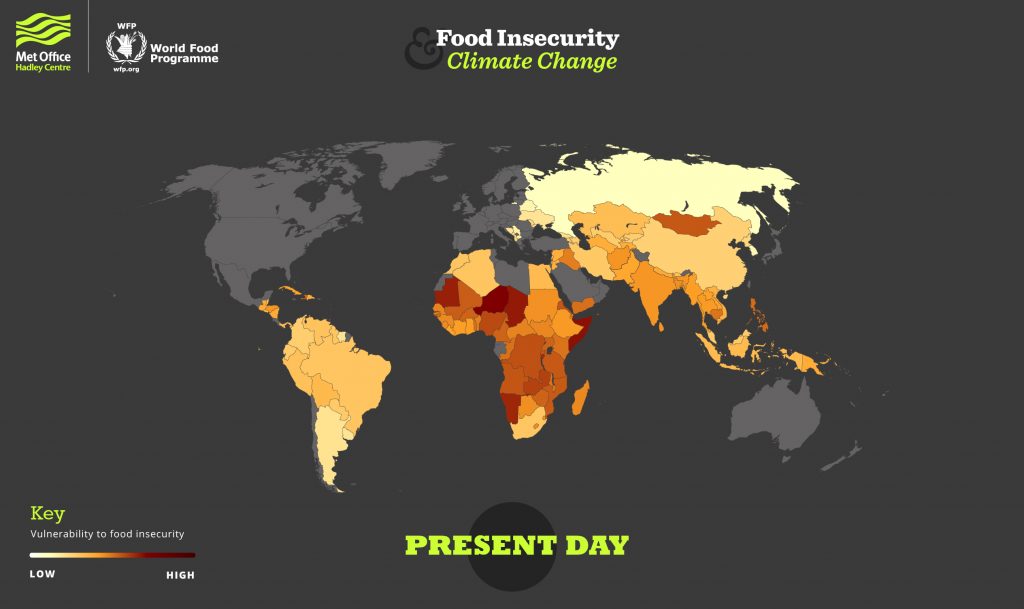80% of human calorie intake comes from 6 major crops including – maize, wheat and rice1. For all people, at all times to have physical and economic access to sufficient food needed for a balanced diet2–food security, the production and distribution of these crops is vital.
 Present day representation of global vulnerability to food insecurity3. Explore scenarios of Greenhouse gas emissions and adaptation to climate change impacts on food security by clicking on the image.
Present day representation of global vulnerability to food insecurity3. Explore scenarios of Greenhouse gas emissions and adaptation to climate change impacts on food security by clicking on the image.
A growing human population increases pressure to enhance crop production. 1 billion ha of land will be converted by 2050 for agriculture, reducing absorption of atmospheric carbon dioxide by plants2 and restoration of gaseous balance in the atmosphere, with fewer plants to act as a CO2 ‘sink’.
Human induced climate change is negatively affecting ecosystems, crop yield and production. Since the industrial revolution greenhouse gas emissions have risen, with atmospheric CO2 levels currently at 406.42ppm4, meaning plants are growing in conditions not experienced for 26 million years5.
Impacts of future climate change are predicted to be severe, varying between regions, through changes in temperature, precipitation and increases in extreme weather events. Methods of crop production such as sustainable intensification are needed to increase yields and overcome threats to livelihoods and food security2.
Will increased CO2 result in higher crop yields?
During photosynthesis plants use CO2, water and light to produce oxygen and carbohydrates for growth. Efficiency of this depends on the enzyme Rubisco, which functions better in high CO2, shown experimentally to increase photosynthesis by 58%5. There is evidence that the number and size of individual cells increase in elevated CO26, showing species specific adaptive ability7, indicating potential to increase crop yield. However other climatic stresses will have negative effects.
The temperature dependant action of Rubisco may become less efficient with rising global temperatures. Furthermore in the long term, plants can acclimatise as additional carbohydrates produced from photosynthesis cannot be used5.
During extended periods of high CO2 exposure the number of stomata- pores used in gaseous exchange in leaves, may decrease indicating that photosynthetic rate will too7.
How will crop production be affected?
For sustainable intensification sufficient water and nutrients8 are required, which will be threatened by increased extreme weather events- from drought affecting water supply to storms where heavy downpours can wash away top soil, reducing land fertility.
Threats to global productivity and changes in yield could have impacts worldwide8. If production decreases, prices of grain products and meat reliant on grain as a feedstock will increase8. Furthermore lower agricultural output, especially in the developing world, leads to lower incomes, with the poorest suffering the most.
High CO2 can decrease food quality with a decline in protein, nitrogen, zinc and iron concentrations in crops9, potentially causing adverse health effects, and necessitating consumption of greater quantities.
Securing the future
FACE (Free-air concentration enrichment) experiments expose crops to elevated CO2 to examine responses and adaptions of ecosystems. Research to develop climate resilient crop varieties to better cope with heat, drought and salinity is also being conducted.
By adapting farming mechanisms and increasing yield and tolerance of essential crop species to environmental extremes, can we ensure food security? Yes, the time to act is now!
Discover more about how farmers may adapt their practices to a changing climate in the video ‘Feeding Nine Billion’10
[499 Words]
References
- Campell, N,A., Reece, J, B., Urry, L,A., Cain, M,L., Wasserman, S, A., Minorsky, P, V., Jackson, R, B. (2015). Seed Plants. In: Wilbur, BBiology A Global Approach. 10th ed. Essex: Pearson. p707.
- Sunderland, T., Powell, B., Ickowitz, A., Foli, S., Pinedo-Vasquez, M., Nasi, R. and Padoch, C. (2013). Food security and nutrition: The role of forests. Center for International Forestry Research. Discussion Paper, p1-20.
- Met Office. (2017).Food Insecurity Climate Change. Available: http://www.metoffice.gov.uk/food-insecurity-index/. Last accessed 18th March 2017.
- CO2 (2017). Earth’s CO2 home page. Available: https://www.CO2.earth/earths-CO2-main-page. Last accessed 20th March 2017.
- Drake, B, G. and Gonzàlez-Meler, M, A. (1997). More Efficient Plants: A Consequence of Rising Atmospheric CO2?.Annual Review of Plant Physiology and Plant Molecular Biology. 48, p609-639.
- Taylor, G., Ranasinghe, S., Bosac, C., Gardner, S and Ferris, R. (1994). Elevated CO2 and plant growth: cellular mechanisms and responses of whole plants. Journal of Experimental Botany. 45 (Special Issue). P 1761-1774
- Long, S, P., Ainsworth, E, A., Rogers, A. and Ort, D, R. (2004). Rising Atmospheric Carbon Dioxide: Plants FACE the Future.Annual Review of Plant Biology. 55, p591-628.
- Nelson, G, C., Rosegrant, M, W., Koo, J., Robertson, R., Sulser, T., Zhu, T., Ringler, C., Msangi, S., Palazzo, A., Batka, M., Magalhaes, M., Valmonte-Santos, R., Ewing, M. and Lee, D. (2009). Climate Change: Impact on Agriculture and Costs of Adaptation.International Food Policy Research Institute. Available at: http://www.fao.org/fileadmin/user_upload/rome2007/docs/Impact_on_Agriculture_and_Costs_of_Adaptation.pdf. Last accessed 19th March 2017
- Myers, S., Zanobetti, A., Kloog, I., Huybers, P., Leakry, A., Bloom, A., Carlisle, E., Dietterich, L., Fitzgerald, G., Hasegawa, T., Holbrook, N., Nelson, R., Ottman, M., Raboy, V., Sakai, H., Sartor, K., Schwartz, J., Seneweera, S., Tausz, M. and Usui, Y. (2014). Increasing CO2 threatens human nutrition. Nature, 510, p139-142
- Fraser, E. (2014). Feeding Nine Billion Video 6: Climate Change and Food Security. Available: https://www.youtube.com/watch?v=cYq2elstFWQ. Last accessed 18th March 2017.
Recent Comments